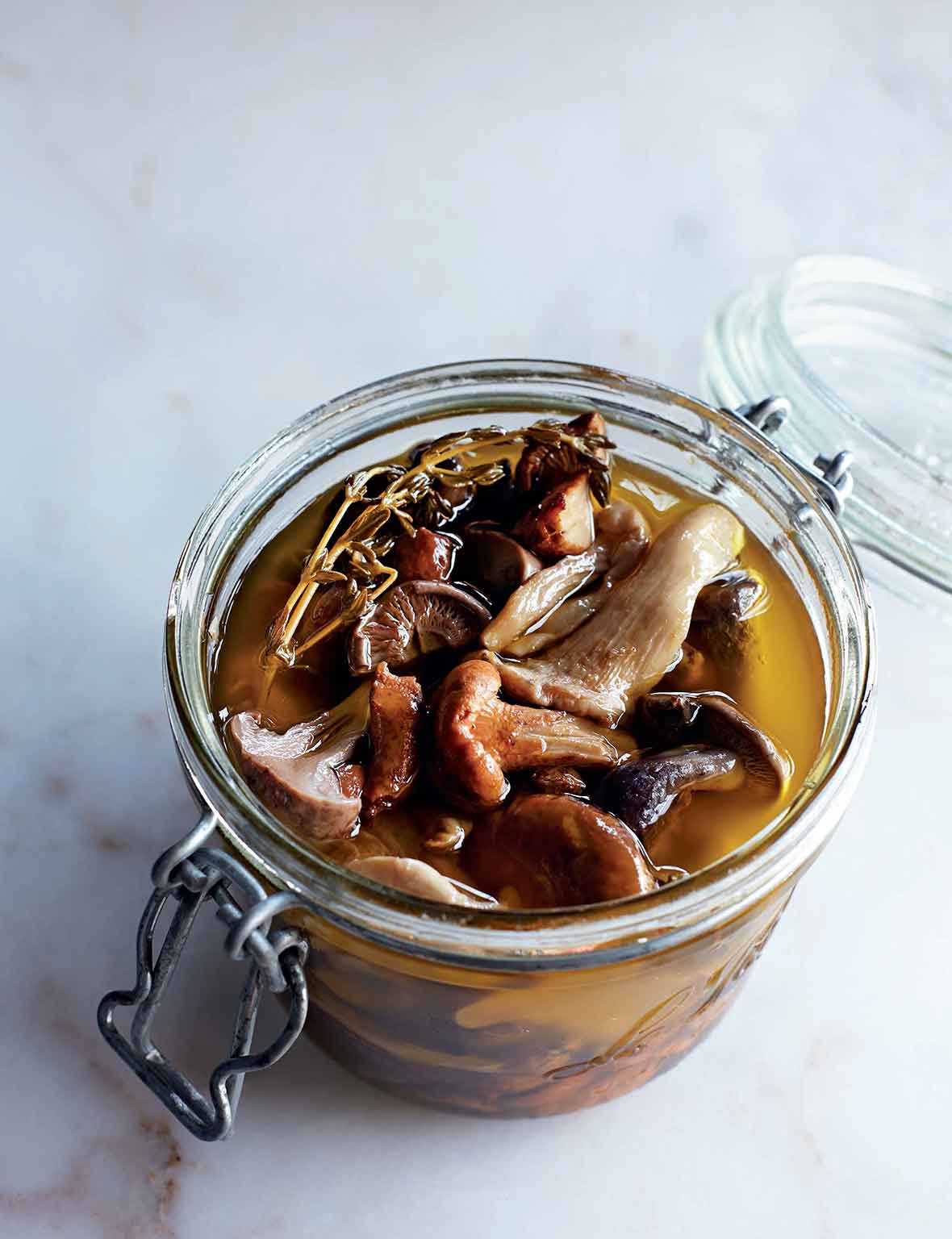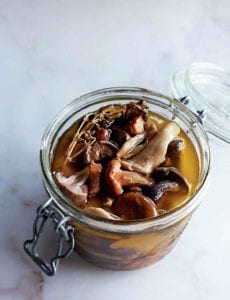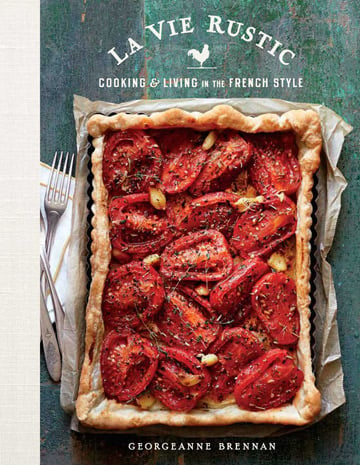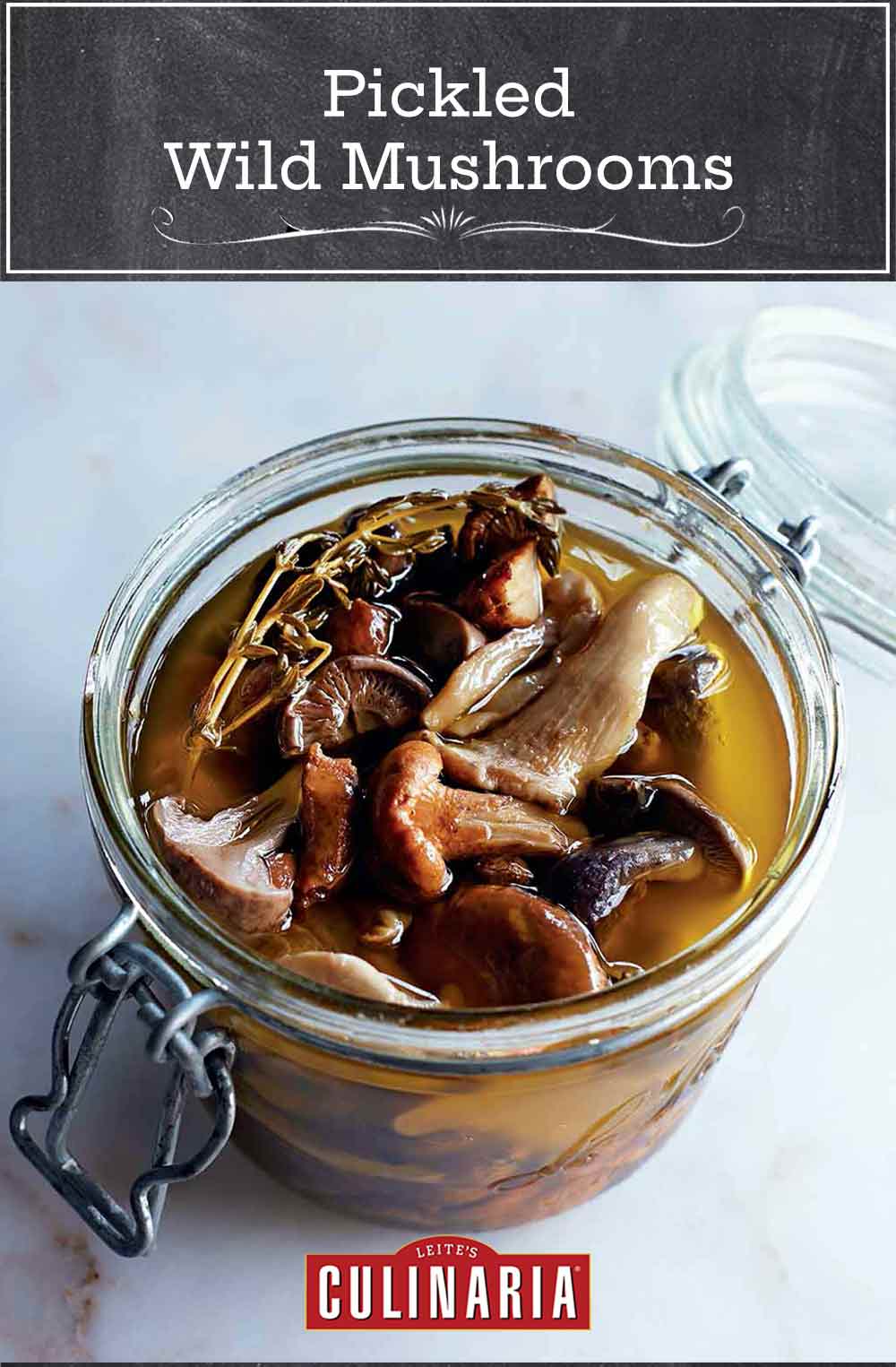
This pickled wild mushrooms recipe is such a wonderfully European thing. Not just in terms of the tradition of preserving something in season but being able to effortlessly pull them from your pantry and set them out with olives and charcuterie next time you have folks over for drinks. Trust us. You’ll be the hostess with the most-est. Provided, natch, that you can keep from snitching the pickled mushrooms as they sit there in your fridge tempting you.–Renee Schettler Rossi

Pickled Wild Mushrooms
Equipment
- 1-pint (16–fluid ounce or 500-ml) canning jar and its lid
Ingredients
- 1/2 pound firm wild mushrooms*
- 1/2 cup extra-virgin olive oil
- 1/2 cup red wine vinegar
- 1/2 teaspoon whole black peppercorns
- 1/4 teaspoon coarse sea salt
- 14 fresh thyme sprigs
Instructions
- Wash a 1-pint (16–fluid ounce or 500-ml) canning jar and its lid in hot, soapy water and dry well.
- If the mushroom stems are firm and meaty, leave the stems intact and trim just the ends of the stems. If the mushroom stems aren’t firm and meaty, trim the stems entirely and discard or save for vegetable broth. Slice the mushroom caps into 1/4-inch (6-mm) slices or cut them into quarters.
- In a nonreactive saucepan over medium-high heat, combine 1/4 cup oil, 1/4 cup vinegar, the peppercorns, salt, and thyme and bring to a boil. Boil for 2 minutes, then add the mushrooms, reduce the heat to low, and cook, turning the mushrooms constantly, for exactly 2 minutes.
- Ladle the mushrooms and hot liquid into the jar. Add the remaining 1/4 cup oil and 1/4 cup vinegar. Cover the jar loosely with aluminum foil and let cool to room temperature. Discard the foil and seal the jar. Refrigerate for at least 24 to 48 hours to allow the flavors to meld. The oil will solidify somewhat due to the cold temperature but will liquefy again at room temperature. (The pickled wild mushrooms will keep in the refrigerator for up to 3 months.)
- Before serving, bring to room temperature. Serve as an hors d’oeuvre alongside cured meats and olives.
Notes
*What You Need To Know About What Kind Of Wild Mushrooms You Can Pickle
Just about any meaty wild mushroom is fair game for pickling. Portobello, trumpet, oyster, cèpes, and morel mushrooms all work spectacularly well as pickles.
Explore More with AI
Nutrition
Nutrition information is automatically calculated, so should only be used as an approximation.
Recipe Testers’ Reviews
This was my very first attempt at pickled mushrooms and I’m glad I tried. The mushrooms—I chose oyster and portobello mushrooms—are juicy with mild vinegar and fruity olive oil and the aroma of fresh thyme is lovely.
I initially thought my 3-quart saucepan with a bottom surface measuring 7 1/2 inches in diameter would be too big for the amount of ingredients, but it turned out to be just the right size. Any smaller and I would have had trouble turning and evenly heating the longer slices of mushrooms. After 2 minutes of cooking, the mushroom slices were somewhat wilted but still quite firm. What a relief it was to see all of them, with the liquid, just fit in the pint jar!
I tasted my mushrooms after 48 hours of pickling and they were delicious by themselves. The pickled wild mushrooms were also wonderful tossed with steamed fingerling potatoes and oil-cured olives and as an accompaniment to steak.
The thought of canned pickled mushrooms at the grocery store makes me cringe when there are quick, easy, and infinitely better pickled mushrooms to be made with your own hands! This pickled wild mushrooms recipe is simple and lets the earthiness of the mushrooms shine through the welcome spike of vinegar and herbs.
While a variety of mushrooms can be used, I found that the meatier mushroom, as the recipe points out, hold up better to the pickling. This recipe can work as a nice base which can be tweaked to your liking with the addition of other herbs, garlic, black peppercorns, etc. I thinly sliced the Trumpet Royale mushrooms after pickling and served them with some shaved Parmigiano and arugula as a nice salad. These always work nicely with a white pizza to really kick it up.
Pickled mushrooms—what an easy addition to a cheese plate. I used king trumpet mushrooms.
The recipe was easy to follow and the pickled mushrooms are nice to have in the fridge. The mushrooms were ready to eat in 24 hours.
A week later, the taste has mellowed a bit but is still yummy. Be sure your slices are in bite-size pieces as the mushrooms still have some tooth to them.
This recipe is what I would term a good return on your effort—a brief prep time, a little planning ahead, and something you will have on hand to perk up an impromptu or planned tapas board. The time to trim, slice, and prepare these mushrooms is maybe 20 minutes, then remembering to do them a day ahead. When you spot some flavorful mushrooms in perfect shape, grab an extra package.
I chose a slightly chef-y assortment that were more interesting than cremini or white mushrooms but not too exotic: beech or Bunashimeji in both brown and white, king trumpets (in the oyster family) and some velvet poppini (which had little matte brown tops which spread out like straw mushrooms when cooked). I would like to have included some maitake, which are even more meaty (aka Hen of the woods) and will do when I see perfect ones. The mushrooms slump down to a perfect pint when you cook them, and the thyme is a nice flavoring.
I was a little short of plain red wine vinegar at the end, and used 2 tablespoons sherry vinegar for part of the last 1/4 cup (will use all sherry in future I think since the end result was a bit brighter than I expected). These took 90-plus minutes to cool while covered with the foil (which kept them warm for a while), then I closed the lid and refrigerated them, patiently waiting for the next day.
I used them on rice to perk up a mild chicken dish and added a couple to an appetizer plate. I will use up more of them tonight with tapas and pizza, drizzling some of this flavored oil that will be left over. I would increase the peppercorns to get a little more heat, or add a dried chile arbole. They will be used up pretty quickly, so I am considering a second batch asap, as these will never see the end of the week. The next batch may be all king trumpet or king oyster as those were my favorrite (although all were lovely).
Definitely worth the wait. I wasn’t impressed with the flavor of these mushrooms after 24 hours. They seemed a little bland. However, I tasted them after 3 days and loved them! The flavors were stronger, more blended, and more impactful the more time they were given.
So far I’ve used them in scrambled eggs, in an easy chicken breast dinner dish, and as part of a sautéed zucchini side dish, and they really added quite a bit of rich, herbally, earthy flavor to everything, and now that they’ve pickled for a bit I enjoy them on their own.
I used a pre-sliced mix of oyster, portobello, and shiitake mushrooms. I definitely would as an accompaniment to an hors d’oeuvre or a main or side dish.
They are simple and sophisticated, and visually beautiful, so even a few of them on a platter or serving tray would enhance the look of a dish. I used a lovely mix mushrooms that included Shimeji, Trumpet Royale, Nameko, Black Poplar, and maitake (I know! I was not previously familiar with all of these exciting mushroom varieties, either!). Based on the photo, I didn’t slice all of my mushrooms into 1/4-inch-thick slices nor did I cut them all into quarters. I liked the look of the whole or closer to whole mushrooms in the photo, and I sought to replicate that look. I was successful with this, and my mushrooms were every bit as delectable looking as those in the photo.
I used a Palestinian olive oil that was seasoned with thyme, so my thyme flavor was amplified. They fit perfectly into my one pint jar.
These would be great with many cheeses, terrific with burgers, or alongside steamed vegetables, especially leafy greens or broccoli. We thought they would be nice as part of a Thanksgiving feast, somewhere adjacent to the cranberries and the stuffing.
If the morel season is as good as last year at the farmers markets, I will go ahead and pickle a batch. Conversely, and from both an accessibility and cost standpoint, I will also go ahead and make a batch with portobellos or creminis in the not-too-distant future.
The recipe is super simple but gives a fantastic end result. The mushrooms are tender and have a lovely flavor. They were a big hit, especially the assorted mushroom version.
I let them sit for a full day before trying them. I then served them a few days later and they were even better. I let them come to room temperature and served them with warm baguette, soft black pepper cheese, and caramalized onions. I used a mixture of shiitake, oyster, and king mushrooms. I also made a second batch of just cremini mushrooms.














